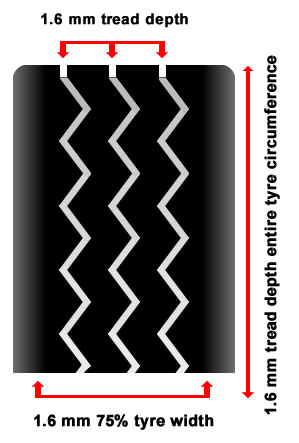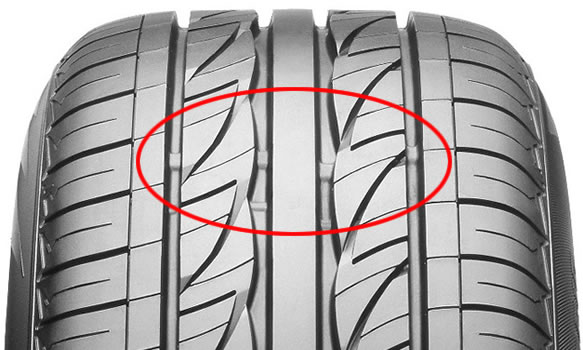It’s very easy to forget about the condition and wear of tyres. The potential issues arising for neglecting tyres can not only lead to penalty points on your licence, but heavy fines in extreme circumstances.
There’s also the increased possibility of an accident occurring due to insufficient tread depth, improper tyre pressures and blow-outs. Consequences can be serious if an accident is a result of badly maintained tyres. This section explains the necessary safety and legal requirements that each vehicle driver should undertake to maintain their tyres.
Legal tyre tread depth
For passenger vehicles excluding motorcycles and vehicles not fitted with more than 8 seats. Goods vehicles that do not exceed a maximum of 3500 kg gross weight and trailers that do not exceed 3500 kg maximum gross weight, the minimum legal tyre tread depth limit must be:
- 1.6 mm tread depth
- 1.6 mm across 75% of the width of the tyre
- 1.6 mm around the entire circumference of the tyre

Other vehicles
For other vehicles larger than those listed above and for motorcycles of 50cc and over, the minimum legal tyre tread depth must be:
- a continuous band of 1 mm tread depth
- 1 mm across a minimum of 75% width of the tyre and around the entire circumference
Tyre tread law
The law with defective tyre offences and / or insufficient tread depth can be severe depending on the circumstances. If a tyre is inspected by a police officer and found to have a tread depth not within the legal limits, they may issue a Fixed Penalty Notice. The tyre fixed penalty is £60 and 3 points on your driving licence. Providing you pay within the date on the fixed penalty notice, no court action will be necessary.
It is the police officers discretion that determines whether a Fixed Penalty Notice is issued or for more serious violations, the officer may wish to prosecute. The maximum fine that a court can impose is £2500 per tyre and 3 penalty points.
Illegal tyres
These are the possible offences that can relate to illegal tyres currently fitted to a vehicle:
- Tyre tread depth must comply with the legal requirements outset above
- Use of cross-ply and radial tyres must be used correctly
- Cuts, bulges and tears may deem a tyre illegal
- Over or under inflated tyres making the vehicle unstable or at risk of a tyre blow-out
- Exposed tyre ply or cord around any part of the tyre
Illegal tyres and car insurance
The least of your concerns are if you get caught by the police if driving on illegal tyres. If you have an accident that is your fault and an inspection concludes that one or more of your vehicles tyres are illegal, it is highly likely that your car insurance will become invalid.
Spare tyre
It isn’t a legal requirement to carry a spare tyre and the condition of the tyre has no consequence while it remains a spare. Once fitted however, it must abide by UK laws.
Tyre check
Before checking the condition of your tyres, ensure you are on a flat surface, with plenty of distance from kerbs, the car is turned off and safely secured with the parking brake.
Tyre tread depth gauges are cheap to purchase and can be found in most car equipment and service stores. Ensure the tyre has a minimum of 1.6 mm of tread depth across at least 75% of the central width of the tyre and around the entire circumference.
Tyre tread markers are available on most tyres as illustrated in the diagram. When the tyre tread becomes level with the markers, the tyre is at its minimum legal limit. Whilst performing the tyre check, ensure there are no deep cuts on the sidewalls and no bulges.

Tyre pressures
The correct tyre pressure for your vehicle can be found inside your vehicle hand book and should be done whilst the tyres are cold. Two tyre pressure are often quoted, one for normal use and another for heavy load. If you no longer have the vehicles hand book, the vehicles manufacturer is able to provide you with this information as will a tyre replacement garage.
Under or over tyre inflation not only increases tyre wear but can affect the grip and braking of the vehicle. Under inflated tyres can potentially lead to overheating and possible breakdown of the tyre. Fuel usage is also increased by under inflated tyres.
Tyre safety
Ideally a quick visual check of each tyre should be made every day before a journey. It’s possible to sustain a slow puncture that may only become evident over a few days. Generally the more mileage you do, the more damage your tyres can potentially sustain and the faster the will wear. Opting for cheap tyres can lead to faster tyre wear and the way you drive can also have an impact. On average however, a more thorough check of the tyres, including tyre pressure, legal tread depth and damage should be checked at least once every month.
Tyres and the MOT
The 15 point check of a car MOT includes the tyres. The spare tyre is not included in the check. The inspection covers the legal condition, security, tyre size and type and tyre tread depth. Tyres that fail to meet the minimum legal requirements will not have an MOT certificate granted for the vehicle. For further information on a car MOT, see:
Tyre wear
Other than the usual tyre wear and tear, there are steps that can be taken to increase the life of a tyre. Having the correct tyre pressure will reduce tyre wear. An over-inflated tyre will cause the centre of the tread area to wear significantly faster than the outside shoulder areas.
Under inflated tyres cause the opposite where the outside of the tyre wears faster than the centre. The tyres PSI (Pounds per Square Inch) can be located in the vehicles hand book. Tyre pressures should be checked regularly and especially before a long journey. Check tyre pressure whilst the tyres are cold.
Whilst driving, if there is any vibration that occurs, this is often a result of the wheels being out of balance. This can cause further tyre wear. To rebalance wheels, ask a tyre replacement garage.
Wheel alignment or tracking can cause uneven tyre wear. You may see that a certain side of your tyre is wearing faster than the rest of the tyre. A car mechanic garage will resolve this issue. Excessive braking and accelerating increase tyre wear as does taking bends at high speed.
Radial and cross-ply tyres
Radial and cross-ply tyres are constructed very differently and have a significant impact on how a vehicle handles. A radial tyres sidewall construction is very flexible, but has a very firm tread area. A cross-ply tyres construction is the opposite with much firmer sidewalls and a more flexible tread area. Especially for transportation vehicles, the tyre wear, traction and stability is very different for each construction type. Due to this, it is illegal to use different tyre construction types on the same axle.
Mixing tyres
If the tyres need changing on your car, keeping to the same make and model of tyre may make for better road handling and smoother drive. Of course, it isn’t always possible to find the same make and model of tyre, especially if your local garage doesn’t stock your particular model any longer. It isn’t economical to replace an entire set, if you just need to replace one or two tyres.
Mixing different brands of tyres providing they are the same construction type ( radial and cross-ply) is acceptable for many makes and models of cars. You could think of it as an athlete wearing a different make of trainer on each foot. Each one will provide a different level of comfort and grip, the same can be said for tyres.
Essentially, if you are a safe driver, read the road ahead well and take bends at a sensible speed, mixing tyres is fine and little difference will be noticed. A driver of a sports car that drives a little faster, is likely to benefit from the same make and model of tyres on each wheel. Consult your vehicles handbook or seek the advice of a professional if you are unsure. If replacing a single tyre, ensure that it is the same size and speed rating as your other tyres.

Hello I have mini cooper r 59 model year 2013 . 0n the big dial all lights go off . But the small speedo in front of me the TPM in red will come on every five seconds Cannot set brakes or oil dates because the TPM light thank you Terry